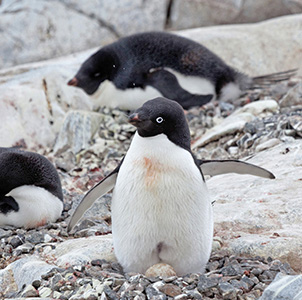|
Year-to-Year Changes in Penguin Populations Difficult to Understand and Predict, Researchers Say 
National Science Foundation Posted October 17, 2017 An analysis of all known data on Adélie penguin populations over the last 35 years has found that only a small fraction of year-to-year changes in Adélie penguin populations can be attributed to measurable factors such as changes in sea ice. The new study, by OPP-funded researchers at New York’s Stony Brook University, indicates that it is difficult for scientists to understand fluctuations of Adélie penguin populations in Antarctica from year-to-year. “In many ways, our study shows that watching Adélie penguin abundance may be like watching the stock market—short term fluctuations may be exceptionally hard to predict and may not signal any change in the fundamental health of the system,” explains senior author Heather Lynch, associate professor of Ecology & Evolution at Stony Brook. Instead, the researchers assert, most of the short-term fluctuations in the number of penguins breeding has no known cause; such ‘noise’ in the system is likely due to a host of marine and terrestrial factors that have not, or cannot, be measured at the majority of sites where penguins breed. The finding, detailed in the paper “Pan-Antarctic analysis aggregating spatial elements of Adélie penguin abundance reveals robust dynamics despite stochastic noise,” is important because it means that tracking abundance at individual colonies, one of the cornerstones of monitoring the health of the Antarctic ecosystem, may not provide a reliable signal on short time scales. Read more on the Stony Brook Website here: https://news.stonybrook.edu/research/volatility-of-penguin-population-requires-new-approaches-to-track-marine-health/
|
Year-to-Year Changes in Penguin Populations Difficult to Understand and Predict, Researchers Say...



For USAP Participants |
For The Public |
For Researchers and EducatorsContact UsU.S. National Science FoundationOffice of Polar Programs Geosciences Directorate 2415 Eisenhower Avenue, Suite W7100 Alexandria, VA 22314 Sign up for the NSF Office of Polar Programs newsletter and events. Feedback Form |

